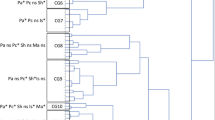Abstract
Large scale landscape transformation and contingent habitat loss are among the greatest threats to ecological integrity and ecosystem health. One of the mitigation approaches used to deal with these pressures is to leave interconnected corridors and nodes as remnant ecological networks (ENs) within the transformed landscape. The South African forestry industry has already allocated 500,000 ha, one-third of the plantation holdings, consisting predominantly of natural grassland, as ENs among and within timber plantations. These ENs are intended to maintain structural, compositional and functional biodiversity. However, little scientific research is available on the effectiveness of these huge ENs for biodiversity conservation and maintenance of natural ecosystem function, although initial findings are encouraging. While the local adverse effect of alien plantation trees on functional biodiversity is not in dispute, it is at the scale of the whole landscape where there is much interest in determining how effective these ENs are in maintaining the untransformed portion of the transformed landscape in a close-to-natural state. As these ENs are extensive, species beta diversity is a consideration in addition to alpha diversity. Initial findings reveal diminished ecological integrity in narrow corridors due in part to the adverse edge effect from the alien trees into the margin of the EN. Quality of the ENs is of great importance for maintaining functional diversity, with human disturbance reducing their effectiveness. First findings, and their application to the Framework for Ecosystem Service Provision, suggest that these ENs are significant for biodiversity conservation and for provision of ecosystem services. Nevertheless, still much more research is required on a greater range of taxa, and their interactions, to improve the design of these ENs for ecological and evolutionary processes.





Similar content being viewed by others
References
Allan DG, Harrison JA, Navarro RA, van Wilgen BW, Thompson MW (1997) The impact of commercial afforestation on bird populations in Mpumalanga Province, South Africa—insights from bird-atlas data. Biol Conserv 79:173–185
de Almeida Vieira F, de Carvalho D (2008) Genetic structure of an insect-pollinated and bird-dispersed tropical tree in vegetation fragments and corridors: implications for conservation. Biodivers Conserv 17:2305–2321
Armstrong AJ, van Hensbergen HJ (1994) Comparison of avifaunas in Pinus radiata habitats and indigenous riparian habitat at Jonkershoek, Stellenbosch. S Afr J Wildl Res 24:48–55
Armstrong AJ, van Hensbergen HJ (1995) Effects of afforestation and clear-felling on birds and small mammals at Grootvadersbosch, South Africa. S Afr For J 174:17–21
Armstrong AJ, van Hensbergen HJ (1996) Impacts of afforestation with pines on assemblages of native biota in South Africa. S Afr For J 175:35–42
Armstrong AJ, Benn G, Bowland AE, Goodman PS, Johnson DN, Maddock AH, Scott-Shaw CR (1998) Plantation forestry in South Africa and its impacts on biodiversity. S Afr For J 182:59–65
Bennett AF (1999) Linkages in the landscape: the role of corridors and connectivity in wildlife conservation. IUCN, Gland, Switzerland
Berggren A, Birath B, Kindvall O (2002) Effect of corridors and habitat edges on dispersal behavior, movement rates and movement angles in Roesel’s bush cricket (Metrioptera roeseli). Conserv Biol 16:1562–1569
Berkes F, Folke C (eds) (1998) Linking social and ecological systems: management, practices and social mechanisms for building resilience. Cambridge University Press, Cambridge, UK
Boitani L, Falcucci A, Moriorano L, Rondinini C (2007) Ecological networks as conceptual frameworks or operational tools in conservation. Conserv Biol 21:1414–1422
Brockerhoff EG, Jactel H, Parrotta JA, Quine CP, Sayer J (2008) Plantation forests and biodiversity: oxymoron or opportunity? Biodivers Conserv 17:925–951
Bullock WL, Samways MJ (2005) Conservation of flower–arthropod interactions in remnant grassland linkages among pine afforestation. Biodivers Conserv 14:3093–3103
Burel F, Baudry J (1995) Farming landscapes and insects. In: Glen DM, Greaves MP, Anderson HM (eds) Ecology and integrated farming systems. Wiley, Chichester, UK, pp 203–220
Chetkiewicz C-LB, Cassidy St. Clair C, Boyce MS (2006) Corridors for conservation: integrating pattern and process. Annu Rev Ecol Syst 37:317–342
Dawson TP, Rounsevell MDA, Kluvánková-Oravská T, Chobotová V, Stirling A (2009) Dynamics of complex adaptive ecosystems for service provision. Biodivers Conserv (submitted)
DWAF (Department of Water Affairs and Forestry) (2005) PCI&S final version 2005. Department of Water Affairs and Forestry, Pretoria, South Africa. Available via http://www.dwaf.gov.za. Accessed 14 Nov 2008
DWAF (Department of Water Affairs and Forestry) (2006) Abstract of South African forestry facts for the year 2004/2005. Department of Water Affairs and Forestry, Pretoria, South Africa. Available via http://www.dwaf.gov.za. Accessed 14 Nov 2008
Dye P, Jarmain C (2004) Water use by black wattle (Acacia mearnsii): implications for link between removal of invading trees and catchment streamflow response. S Afr J Sci 100:40–44
EEA (European Environmental Agency) (1995) Europe’s environment: the Dobris assessment. European Environment Agency, Copenhagen, Denmark
Eeley HAC, Lawes MJ, Macfarlane D (2002) Historical change since 1944 in landscape pattern of indigenous forest in the KwaZulu-Natal Midlands. In: Seydack AHW, Vorster T, Vermeulen WH, van der Merwe JJ (eds) Multiple use management of natural forests and Savanna woodlands: policy refinement and scientific progress. Proceedings of the natural forests and Savanna woodlands symposium III, Kruger Park, May 2002. Department of Water Affairs and Forestry, Pretoria, South Africa, pp 68–78
Fahrig L (2003) Effects of habitat fragmentation on biodiversity. Annu Rev Ecol Syst 34:487–515
Field LF (2002) Consequences of habitat fragmentation for the pollination of wildflowers in moist upland grasslands of KwaZulu-Natal. Dissertation, University of Natal, South Africa
Forman RTT (1995) Land mosaics: the ecology of landscapes and regions. Cambridge University Press, Cambridge, UK
FSC (Forest Stewardship Council) (1996) FSC international standard: FSC principles and criteria for forest stewardship. FSC-STD-01-001 (version 4-0). Available via http://www.fsc.org. Accessed 14 Nov 2008
Hess GR, Fischer RA (2001) Communicating clearly about conservation corridors. Landsc Urban Plan 55:195–208
Hill CJ (1995) Conservation corridors and rainforest insects. In: Watt AD, Stork NE, Hunter MD (eds) Forests and insects. Chapman and Hall, London, UK
Hilty JA, Lidicker WZ, Merenlender AM (2006) Corridor ecology: the science and practice of linking landscapes for biodiversity conservation. Island Press, Washington DC, USA
Jackelman J, Wistebaar N, Rouget M, Germishuizen S, Summers R (2006) An assessment of the unplanted forestry land holdings in the grasslands biome of Mpumalanga, KwaZulu-Natal and the Eastern Cape. SANBI Grasslands Programme No 8. Grasslands in Working Landscape Series, South Africa National Biodiversity Institute, Pietermaritzburg, South Africa
Jongman RHG (1995) Nature conservation planning in Europe: developing ecological networks. Landsc Urban Plan 32:169–183
Jongman RHG, Pungetti G (2004) Ecological networks and greenways: concept, design, implementation. Cambridge University Press, Cambridge, UK
Kinvig R, Samways MJ (2000) Conserving dragonflies (Odonata) along streams running through commercial forestry. Odonatologica 29:195–208
Kirkman KE, Pott RM (2002) Biodiversity conservation in plantation forestry. In: Pierce SM, Cowling RM, Sandwith T, MacKinnon K (eds) Mainstreaming biodiversity in development—case studies from South Africa. The World Bank Environmental Department, Washington DC, USA, pp 33–42
Lawes MJ, Everard D, Eeley HAC (1999) Developing environmental criteria and indicators for sustainable plantation management: the South African perspective. S Afr J Sci 95:461–469
Le Maitre DC, van Wilgen BW, Chapman RA, McKelly DH (1996) Invasive plants and water resources in the Western Cape Province, South Africa: modelling the consequences of lack of management. J Appl Ecol 33:161–172
Luck G, Daily GC, Ehrlich PR (2003) Population diversity and ecosystem services. Trends Ecol Evol 18:331–336
Luck G, Harrington R, Harrison PA, Kremen C, Berry PM, Bugter R, Dawson TP, de Bello F, Díaz S, Feld CK, Haslett JR, Hering D, Kontogianni A, Lavorel S, Rounsevell M, Samways MJ, Sandin L, Settele J, Sykes MT, van den Hove S, Vanderwalle M, Zobel M (2009) Quantifying the contribution of organisms to the provision of ecosystem services. Bioscience 59:223–235
MA (Millennium Ecosystem Assessment) (2005) Ecosystems and human well-being: biodiversity synthesis. World Resources Institute, Washington DC, USA
McKenna DD, McKenna KM, Malcolm SB, Berenbaum MR (2001) Mortality of Lepidoptera along roadways in central Illinois. J Lepid Soc 55:63–68
Mucina L, Rutherford MC (2006) The vegetation of South Africa, Lesotho and Swaziland. Strelitzia 19. South African National Biodiversity Institute, Pretoria, South Africa
Nasi R, Koponen P, Poulsen JG, Buitenzorgy M, Rusmantoro W (2008) Impact of landscape and corridor design on primates in a large-scale industrial tropical plantation landscape. Biodivers Conserv 17:1105–1126
Neke KS, du Plessis MA (2004) The threat of transformation: quantifying the vulnerability of grasslands in South Africa. Conserv Biol 18:466–477
Pryke SR, Samways MJ (2001) Width of grassland linkages for the conservation of butterflies in South African afforested areas. Biol Conserv 101:85–96
Pryke SR, Samways MJ (2003) Quality of remnant indigenous grassland linkages for adult butterflies (Lepidoptera) in an afforested African landscape. Biodivers Conserv 12:1985–2004
Pryke JS, Samways MJ (2009) Recovery of invertebrate diversity in a rehabilitated city landscape mosaic in the heart of a biodiversity hotspot. Landsc Urban Plan 93:54–62
Reyers B, Fairbanks DHK, van Jaarsveld AS, Thompson M (2001) Priority areas for the conservation of South African vegetation: a coarse-filter approach. Divers Distrib 7:79–95
Rosenberg DK, Noon BR, Meslow EC (1997) Biological corridors: form, function, and efficacy. Bioscience 47:677–687
Rounsevell M, Dawson TP, Harrison PA (2009) A conceptual framework to analyse the effects of environmental change on ecosystem services. Biodivers Conserv (submitted)
Samways MJ (2007a) Implementing ecological networks for conserving insect and other biodiversity. In: Stewart AJA, New TR, Lewis OT (eds) Insect conservation biology. CABI, Wallingford, Oxon, UK, pp 127–143
Samways MJ (2007b) Insect conservation: a synthetic management approach. Annu Rev Entomol 52:465–487
Samways MJ, Moore SD (1991) Influence of exotic conifer patches on grasshopper (Orthoptera) assemblages in a grassland matrix at a recreational resort, Natal, South Africa. Biol Conserv 57:117–137
Samways MJ, Taylor S, Tarboton W (2005) Extinction reprieve following alien removal. Conserv Biol 19:1329–1330
Smith DS, Hellmund PC (eds) (1993) Ecology of greenways. University of Minnesota Press, Minneapolis, USA
Tewari DD (2001) Is commercial forestry sustainable in South Africa? The changing institutional and policy needs. Front Ecol Environ 2:333–353
Townsend PA, Levey DJ (2005) An experimental test of whether habitat corridors affect pollen transfer. Ecology 86:466–475
Van Wilgen BW, Le Maitre DC, Reyers B, Schonegevel L, Richardson DM (2006) A preliminary assessment of the impacts of invasive alien plants on ecosystem services in South Africa. In: Preston C, Watts JH, Crossman ND (eds) 15th Australian weeds conference, papers and proceedings, Adelaide, South Australia, 24–28 September 2006. Managing weeds in a changing climate. Weed Management Society of South Australia, Victoria, Australia, pp 819–822
Acknowledgments
We thank Peter Gardiner and Paula Harrison for stimulating discussion. This review is a contribution to the RUBICODE Coordination Action Project (Rationalising Biodiversity Conservation in Dynamic Ecosystems) funded under the Sixth Framework Programme of the European Commission (Contract No. 036890). CSB also acknowledges financial support from the Mauerberger Foundation, and MJS and JSP from Mondi.
Author information
Authors and Affiliations
Corresponding author
Rights and permissions
About this article
Cite this article
Samways, M.J., Bazelet, C.S. & Pryke, J.S. Provision of ecosystem services by large scale corridors and ecological networks. Biodivers Conserv 19, 2949–2962 (2010). https://doi.org/10.1007/s10531-009-9715-2
Received:
Accepted:
Published:
Issue Date:
DOI: https://doi.org/10.1007/s10531-009-9715-2




